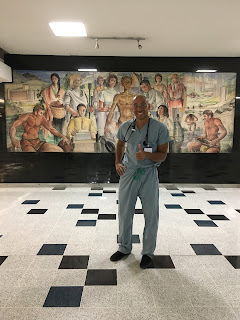Devan
Bartels, MD, MPH
Resident in the Department of Anesthesiology, Critical Care
and Pain Medicine at Massachusetts General Hospital
PGY4
Moving Anesthesia and Critical Care Forward in Botswana
Our trip to Botswana is winding down, and we return to the
United States this week. It has been an incredible month of new experiences,
constant learning, and meeting inspiring people. David and I have many people
to thank for helping make this experience possible, including, but we are sure
not limited to, the Department of Anesthesiology, Critical Care and Pain
Medicine at MGH (especially Drs. Paul Firth and Lena Dohlman), the University
of Botswana Department of Anaesthesia and Critical Care (especially Dr.
Neguisse Bekele), the wonderful staff at Princess Marina Hospital, the Partners
COE program, and MGH Global Health.
 |
| Drs. David Bartels, Lena Dohlman, and Devan Bartels in front of the new teaching hospital. |
After a month of striving to achieve our mission of
education and capacity assessment, we are heartened that we were able to
provide significant supplementary medical student and staff anesthetist
education, and we are encouraged by the potential we see for developing
anesthesia and critical care capacity in Botswana. A major goal of ours was to
convey our enthusiasm for the field of anesthesia and the unique skillset it
provides the healthcare system. We have been happy to hear several students
express to us that they are now considering becoming anesthesiologists! This is
great news and is exactly what is needed. Anesthesia and critical care are
vital aspects to a health system, and capacity for anesthesia and critical care
is needed in Botswana.
During this last week, we have continued to help teach
medical students in the operating rooms and during tutorials. A major theme for
our teaching has been safety in obstetric anesthesia, and topics have included
postpartum hemorrhage, airway management in the parturient, and appropriate
selection of anesthetic technique. In the tutorial sessions, we have discussed
monitoring, acid/base status, and vasoactive medications. We have also
participated in several case presentations. These sessions are a lot of fun and
are perhaps good oral board exam preparation! A student will present a case
(e.g. 25 yo female for emergent ex lap…) and then the staff UBSOM
anesthesiologist will ask the presenter and her colleagues about appropriate
management of the patient. Most often, this discussion starts with the
question, “How would you anesthetize this patient?” From this starting point,
an organic conversation emerges with students and staff asking questions,
offering opinions, and arriving at management consensus. Finally, in addition
to our educational work, we have had the chance to learn more about the
Botswana-Harvard Partnership and the University of Botswana School of Medicine.
This has been invaluable as we learn how to improve future efforts and
coordinate with existing programs.
As our time in Botswana draws to a close (for now!), the
major question that we now ask ourselves is: What is the path forward for
anesthesia and critical care capacity in this remarkable country, especially as
the morbidity and mortality of non-communicable disease (especially preventable
surgical disease) increase? We have witnessed firsthand the hard work that is
already happening and can see the future potential. We know that future
development will likely be slow because it requires development of the most
precious asset – human capital. This will require real investments in existing
staff, recruitment of new (likely foreign) anesthesiologists, and of course,
development of the next generation of Batswana anesthesiologists and critical
care specialists. It will not be easy, but whatever the path, we have been
honored to help at this stage and hope to participate in the future to help
create sustainable Botswana anesthesia and critical care capacity. We are eager
to return to Boston and further share our experiences and lessons learned. Ke a
leboga and thank you!











